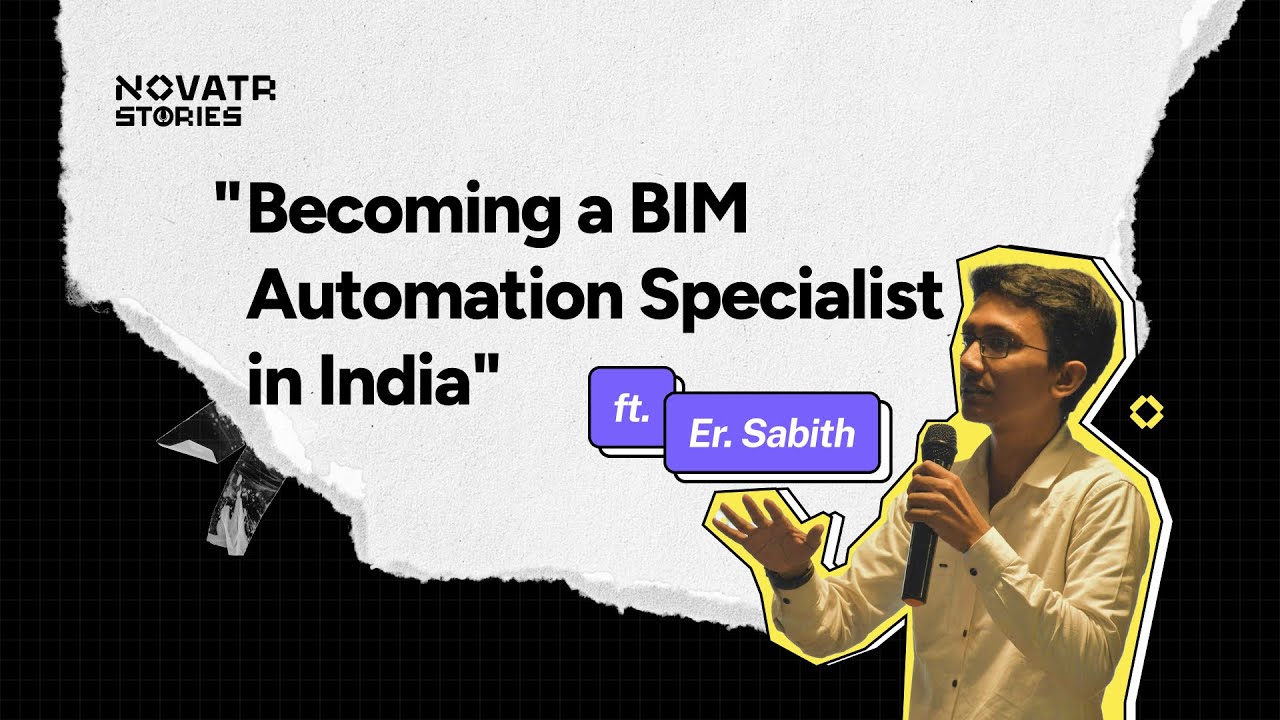Becoming a BIM Automation Specialist in India l Story of Er. Mohamed Sabith

Table of Contents
Curiosity killed the cat? Not for this BIM Automation Specialist!
This is the story of Er. Mohamed Sabith, a BIM Engineer turned Automation Specialist, hailing from Chennai, Tamil Nadu. He carved his path in the AEC industry by staying curious, embracing tech, and never giving up.
Continue reading to find out what made him pick the AEC industry, and how Novatr became a part of his bigger picture.
Sabith, to get started, if you have to reflect on the beginning of the journey where would you start your story from?
I wasn't a visionary who always dreamed of becoming a civil engineer. I made that decision only after high school. As a child, I wanted to do something creative. I was good with technology and even built a laser security system in seventh grade. I learned everything from YouTube—all open source. I bought electronics from a local store with money from my grandfather (since my father doubted my abilities). I built it for my school's annual science exhibition, wanting to do something different from typical projects like potato clocks. This experience gave me insight into engineering and problem-solving.
College life was interesting because I wasn't studious during school. Though creative and tech-savvy, I wasn't a bookworm and didn't perform well in high school. When I joined college, things improved, but the first year was mostly basic physics and chemistry—similar to high school. So, I still struggled initially.
Also read: BIM Metamorphosis - A Paradigm Shift in the AEC Industry
You have been working as an automation specialist at Lambert. So, could you tell us how that happened? Finding a niche for yourself in that industry?
Finding my niche as an automation specialist has been interesting. It's truly a specialized area within BIM, and I wanted to carve out my own space. While everyone knows automation saves time, computers work faster than humans; what's often overlooked is the quality of output. Humans making repetitive tasks inevitably make mistakes, but computers don't if given correct inputs. My mantra is simple: if you're spending more than five minutes on something you do more than five times daily, automate it. Otherwise, you'll waste time on tedious work instead of creative tasks.
How challenging is it to find a job in the AEC industry?
I worried about placements since civil engineering companies rarely came to campus, unlike CS students who got high-paying offers. Fortunately, I secured a job after graduation. College went smoothly overall. For my final year project, we had the School of Infrastructure dean as our advisor—unusual for bachelor's projects. This connection significantly impacted my career, giving me access to IIT Madras networks and workshops.
My first job came through an IIT Madras contact—a project officer I met when he conducted a STAAD Pro workshop at our college. He later invited me to the IIT Madras programs. I graduated in 2020, the "coronavirus year," which cut our project short due to the lockdown. Despite my incomplete degree, he trusted me enough to offer me a part-time structural engineering role. There, I tried implementing BIM workflows, as I'd already decided to pursue BIM. After graduation, I formally moved into the BIM field by actively seeking and seizing opportunities.
I tried to build as many contacts as possible.
How to start your career in BIM: Software and industry requirements for BIM jobs in 2025
You worked as a Structural Engineer at the beginning of your career. What was that like?
I was really fortunate to get a job as a structural engineer at the beginning of my career. My interest in structural engineering began with "Mechanics of Solids" in my second year of Undergrad. I found it fascinating to learn how structures stand, their required strength, and load transfer paths. Oddly, I never seriously considered a career in structural engineering until I landed my first job in the field. Working at that small company taught me more in eight months than my entire four years of college. I handled everything from design to documentation to drafting, which accelerated my learning tremendously. This experience confirmed that learning through practice is far more effective than learning from textbooks—it was a crucial period in my development.
Also read: Top 10 Advantages of Revit for Structural Engineers
How did you end up learning industry-relevant software like Revit?
I was introduced to Revit through a workshop organized by my college, where a company conducted training for students. That was my first interaction with Revit, and I liked it—this moment marked the beginning of my BIM journey. Though I wasn't an expert after the workshop, I received a certificate and wanted to learn more.
To expand my knowledge, I explored online resources on LinkedIn Learning, Udemy, and YouTube. Since free courses often lack accountability, I invested in paid courses on Udemy and LinkedIn, which I completed during COVID when regular classes were suspended.
I created a resume outlining the skills I needed, using it as a roadmap. After mastering Revit, I learned Navisworks through YouTube tutorials, covering basics and clash detection. I also wanted to learn Autodesk Construction Cloud (formerly BIM 360), but couldn't find good tutorials. Instead, I studied the theoretical aspects—what it does and why it's used—which still helped me in interviews. I also knew AutoCAD from earlier training.
Benefits of Using Revit in Architecture, Civil Engineering and MEP
What does a workday look like for a BIM Automation Specialist?
That depends on the type of company and projects you're involved in. If you're working with a BIM consultancy, you'll usually get 2D inputs from clients—like structural, architectural, or MEP consultants—and your main task is to convert them into 3D models and coordinate across disciplines.
In a structural consultancy, like my experience at Covey and Ramboll, the BIM and design teams work closely. Designers share their models and analysis with us, and we create structural models based on that. As they update the design, we revise the models and drawings accordingly. Coordination with other disciplines is continuous and forms a feedback loop.
Overall, no matter the company, it usually starts with a base—like a sketch, drawing, or initial model—and especially as a beginner, your key role is to build accurate 3D models from those inputs.
What inspired you to start mentoring? What’s been the most rewarding part of your journey with Novatr?
Being part of the BIM for Civil Engineers course as a Novatr Mentor has been a very rewarding experience. I was also part of the team that helped design the curriculum, so I can confidently say it’s a comprehensive and practical course, especially for beginners in BIM.
The highlight, in my opinion, is the capstone project—particularly the metro project. It gives learners a chance to simulate a real-world scenario, and that’s incredibly valuable. The entire project follows ISO 19650 standards, and it’s divided into eight phases, just like a real project would be. This allows students not only to learn the tools but also to understand real-life workflows, which prepares them better for the job environment.
What sets the course apart, though, is the community. You're learning from actual professionals in the industry—people who may one day hire you or work alongside you. That industry interaction makes a big difference. In one of my recent cohorts, we had learners from across five countries. These weren’t just students; many were working professionals from different areas of civil engineering, and they brought unique insights. I learned from them as much as they learned from me.
Who Uses BIM? Industries That Rely on This Game-Changing Tech in 2025
What do you think is your superpower as a Novatr Mentor?
I’d say my superpower is teaching—specifically, simplifying complex topics into small, understandable bits. I’ve been told that I explain things in a way that’s very easy to grasp, and I take pride in that. Working as a mentor and innovator at Novatr has given me the perfect platform to put that skill to good use.
Want to learn more about the AEC industry? Watch the complete interview and get insights from our Mentor.
If you are interested to learn with Er. Mohamed Sabith and all our experienced mentors, join Novatr’s BIM Professional Course. Trusted by 5,000 (and counting) learners worldwide, our courses are designed to equip you with technical tools and foster in-demand, industry-relevant skills. Taught by professionals from top AEC firms globally, the courses help you bridge the gap between academics and real-world knowledge.
For more resources on BIM, parametric design, software & tools, industry trends, and career, head to the Resources.
About the Mentor

Er. Mohamed Sabith is a BIM Automation Specialist with over 5 years of experience in leveraging technology to enhance Revit workflow, Dynamo, Revit API, and programming in Python and C#. He is also a Novatr mentor who believes that learning never stops.
Check him out on LinkedIn

 Thanks for connecting!
Thanks for connecting!


.png)
.jpg)





